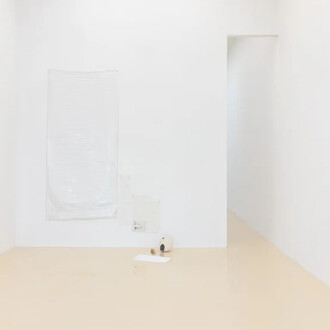Tomashi Jackson’s multimedia practice places formal and material investigations in dialogue with recent histories of displacement and disenfranchisement. Drawing centrally from Josef Albers’ research on the relativity of color and the unconscious processes by which the brain organizes and reconciles information, Jackson’s work bridges gaps between geometric experimentation and the systematization of injustice, incorporating images hand-painted from photographs and materials chosen for their relevance into formalist compositions.
Jackson’s latest body of work principally concerns the question of democracy, taking up its conceptual origins in Ancient Greece, with its contingent notion of obligatory civic participation. She compares this history of democracy to the realities of the present-day United States, with particular attention to the Voting Rights Act of 1965, written to prevent discriminatory practices at the state and local levels that prevented Black Americans from exercising their right to vote. Jackson cites the enactment of this law as the true beginning of American democracy, though she points to subsequent public crises – the rise of gerrymandering and the the crack epidemic that began in Los Angeles in the 1980s – to question democracy’s true status in the US today.
The works in Forever My Lady trace these histories through strategic use of material, including ephemera from recent contested elections in the US and recent ballot materials from Greece. Jackson also crosshatches images from a wide array of sources, including portraits of investigative journalist Gary Webb, whose reporting exposed the CIA’s role in the crack cocaine trade; the damning photographs that implicated US Presidents Reagan and Bush Sr. in this activity; and photos from her own family archives. Mounted on wedge-like frames that protrude at right angles from the wall, the works become sculptural, taking on the appearance of the low-profile awnings that characterize the Athenian cityscape and suggesting metropolitan space as it defines our notions of society and community.
Though the works offer analysis at a sociological scale, they are also intimately defined by the artist’s personal experiences, born out of her own recent residency in Athens as well as her Los Angeles upbringing. Indeed, projected throughout the exhibition are original music videos set to R&B songs, chosen to reflect Jackson’s own history and as well as the possibility of music as another avenue to collective memory. In tandem with the rest of the exhibition, the works explore the possibility of personal fulfillment within a ruthless structure. She writes,
This work [...] places the myths of American democracy in visual collision with its perverted reality (suppression of Black voters and the crack explosion of the eighties). Something of an excavation of origin for the idea of Democracy and the fact of what we have actually experienced. After walking through ancient ruins and seeing marks of humanity surviving and mourning, I thought of the impact on a people whose humanity has been consistently compromised, debated, and undermined. What mania must naturally arise when our behavioral links to all other people and civilizations of the world, knowable by respect for cultural antiquity, has been severed and we have been left othered like a side show? What is the impact of denied public recognition of crimes against our humanity sold to us as normal alongside the notion of the supremacy of American democracy and exceptionalism?
Masterful formal compositions in their own right, Jackson's works immediately attract the viewer with exuberant color, bold geometries, and intricate layerings of material, affirming the vitality of visual art. Her evocative materials and optical illusions provoke immediate responses but call for closer attention and consideration, revealing the social crises and personal histories present in all visual experience. Though spirited, the works are mournful testaments to the urgency of what is happening before our eyes.
















